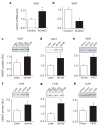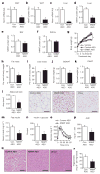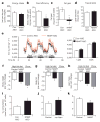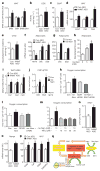Nicotinamide N-methyltransferase knockdown protects against diet-induced obesity
- PMID: 24717514
- PMCID: PMC4107212
- DOI: 10.1038/nature13198
Nicotinamide N-methyltransferase knockdown protects against diet-induced obesity
Abstract
In obesity and type 2 diabetes, Glut4 glucose transporter expression is decreased selectively in adipocytes. Adipose-specific knockout or overexpression of Glut4 alters systemic insulin sensitivity. Here we show, using DNA array analyses, that nicotinamide N-methyltransferase (Nnmt) is the most strongly reciprocally regulated gene when comparing gene expression in white adipose tissue (WAT) from adipose-specific Glut4-knockout or adipose-specific Glut4-overexpressing mice with their respective controls. NNMT methylates nicotinamide (vitamin B3) using S-adenosylmethionine (SAM) as a methyl donor. Nicotinamide is a precursor of NAD(+), an important cofactor linking cellular redox states with energy metabolism. SAM provides propylamine for polyamine biosynthesis and donates a methyl group for histone methylation. Polyamine flux including synthesis, catabolism and excretion, is controlled by the rate-limiting enzymes ornithine decarboxylase (ODC) and spermidine-spermine N(1)-acetyltransferase (SSAT; encoded by Sat1) and by polyamine oxidase (PAO), and has a major role in energy metabolism. We report that NNMT expression is increased in WAT and liver of obese and diabetic mice. Nnmt knockdown in WAT and liver protects against diet-induced obesity by augmenting cellular energy expenditure. NNMT inhibition increases adipose SAM and NAD(+) levels and upregulates ODC and SSAT activity as well as expression, owing to the effects of NNMT on histone H3 lysine 4 methylation in adipose tissue. Direct evidence for increased polyamine flux resulting from NNMT inhibition includes elevated urinary excretion and adipocyte secretion of diacetylspermine, a product of polyamine metabolism. NNMT inhibition in adipocytes increases oxygen consumption in an ODC-, SSAT- and PAO-dependent manner. Thus, NNMT is a novel regulator of histone methylation, polyamine flux and NAD(+)-dependent SIRT1 signalling, and is a unique and attractive target for treating obesity and type 2 diabetes.
Figures




Comment in
-
Metabolism: Targeting a fat-accumulation gene.Nature. 2014 Apr 10;508(7495):194-5. doi: 10.1038/508194a. Nature. 2014. PMID: 24717510 No abstract available.
References
-
- Shepherd PR, Kahn BB. Glucose transporters and insulin action—implications for insulin resistance and diabetes mellitus. N Engl J Med. 1999;341:248–257. - PubMed
-
- Yang Q, et al. Serum retinol binding protein 4 contributes to insulin resistance in obesity and type 2 diabetes. Nature. 2005;436:356–362. - PubMed
-
- Aksoy S, Szumlanski CL, Weinshilboum RM. Human liver nicotinamide N-methyltransferase. cDNA cloning, expression, and biochemical characterization. J Biol Chem. 1994;269:14835–14840. - PubMed
-
- Riederer M, Erwa W, Zimmermann R, Frank S, Zechner R. Adipose tissue as a source of nicotinamide N-methyltransferase and homocysteine. Atherosclerosis. 2009;204:412–417. - PubMed
Publication types
MeSH terms
Substances
Associated data
- Actions
Grants and funding
- P30 DK040561/DK/NIDDK NIH HHS/United States
- R37 DK43051/DK/NIDDK NIH HHS/United States
- K08 DK090149/DK/NIDDK NIH HHS/United States
- P01 CA120964/CA/NCI NIH HHS/United States
- P30 DK046200/DK/NIDDK NIH HHS/United States
- R37 DK043051/DK/NIDDK NIH HHS/United States
- P01CA120964/CA/NCI NIH HHS/United States
- T32 DK007516/DK/NIDDK NIH HHS/United States
- R01 DK069966/DK/NIDDK NIH HHS/United States
- P30 CA006516/CA/NCI NIH HHS/United States
- R01 DK100385/DK/NIDDK NIH HHS/United States
- K01 DK094943/DK/NIDDK NIH HHS/United States
- P30CA006516-46/CA/NCI NIH HHS/United States
- 13SDG14620005/AHA/American Heart Association-American Stroke Association/United States
- R01 DK69966/DK/NIDDK NIH HHS/United States
- P30 DK57521/DK/NIDDK NIH HHS/United States
- P30 DK057521/DK/NIDDK NIH HHS/United States
- R01 DK043051/DK/NIDDK NIH HHS/United States
- P30 DK0460200/DK/NIDDK NIH HHS/United States
LinkOut - more resources
Full Text Sources
Other Literature Sources
Medical
Molecular Biology Databases
Research Materials

